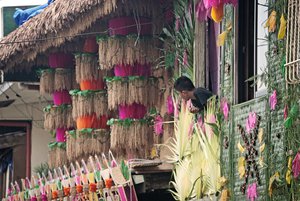Advertisement

 Decorated Houses
Decorated Houses
Every May 15th, houses in Lucban are adorned with kiping and vegetables in honor of St. Isidore the Laborer.Houses are adorned with multicolored leaf-shaped rice wafers and every conceivable vegetable found in the residents’ kitchens. At almost every door, vendors are selling
habhab, stir-fried noodles served on banana leaves and supposed to be eaten without any utensils or hands. And at the town church where throngs of crowd flock for the day’s mass, Naomi emerges with her friend Mark to join me and CJ in exploring the streets. It’s the Pahiyas Festival at Lucban, and the sleepy town in Quezon about a five-hour drive south of Manila has turned raucously merry.
“You don’t see this in Manila,” says Naomi, a former student of mine and a resident in a nearby town. One of the more popular festivals in the Philippines, the Pahiyas is held every 15
th of May in honor of Saint Isidore the Laborer, the patron saint of farmers. Whether to show their gratitude, to wish for a bountiful harvest, to win the top prize for the best decoration, or just to simply join in the show, the residents of Lucban take great pains in dressing their homes with as much produce as they can muster. Visitors are very much welcome to enter the houses and eat

 Pancit Habhab
Pancit Habhab
Stir-fried noodles served on banana leaves are commonly sold during the festival. The noodles are supposed to be eaten using only the mouth.with the families.
In the afternoon, a blur of marionettes sweeps around a narrow platform as the sounds of trumpets, trombones and drums jar the eardrums of the audience. The march halts for a moment before colorful carts carrying vegetables of various colors roll by, followed by towering effigies of different personalities swaying to the beat. The Grand Parade is starting. The crowd gathered in front of the Lucban church breaks into a din of laughter and cheers as a truck throws out candies.
The church is traditionally the starting point of the parade, which goes around town with a motorcade of judges choosing the best decorated house. Unlike most fiestas in the Philippines, the Pahiyas follows a different route every year to give every house in town a chance to participate. “During the parade, houses give out the vegetables used for the decorations to the visitors,” says Travel Factor’s Ayla Liberato, our trip coordinator.
Like the passing parade, everything will return to normal for Lucban in the morning. People will return to work, tourists will return to where they’re from. But for now, everyone’s connected by this sense of merriment, and with this event, the town

 Grand Parade
Grand Parade
Marionettes perform during the afternoon parade in front of the town church.residents are providing a link with visitors to their identity and their culture. That, and a chance to buy another famous Lucban specialty. “Don’t forget to buy longganisa,” Ayla reminds us.
Of course we won’t.
...
Thanks to Travel Factor for organizing the trip and to Naomi Vito Cruz for the "modeling" stint.
Advertisement
Tot: 0.299s; Tpl: 0.012s; cc: 27; qc: 134; dbt: 0.127s; 1; m:domysql w:travelblog (10.17.0.13); sld: 1;
; mem: 1.4mb

 Decorated Houses
Decorated Houses
 Pancit Habhab
Pancit Habhab
 Grand Parade
Grand Parade




